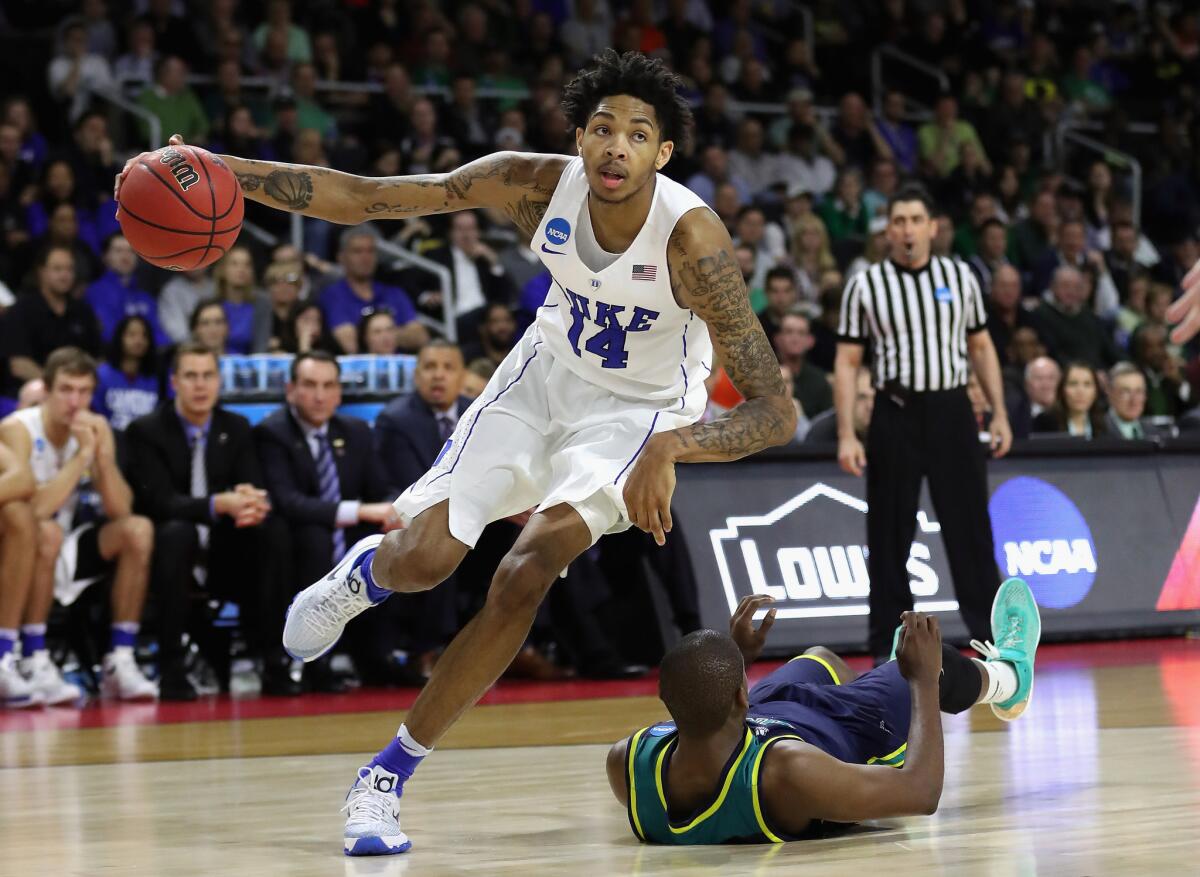Column: College basketball’s so-called one-and-done rule needs revisiting

Duke forward Brandon Ingram (14) drives to the basket in the second half against North Carolina-Wilmington in the first round of the NCAA tournament.
Kobe Bryant doesn’t like the rule. Duke Coach Mike Krzyzewski doesn’t, either.
The NBA’s so-called one-and-done rule requires players to be at least a year removed from high school to be eligible for the draft.
“It didn’t make any sense,” said Bryant, who went directly from high school to the NBA.
Bryant’s right. The rule didn’t make sense when it was implemented in 2005 and it doesn’t make sense now.
The topic will take center court again Thursday at the Honda Center, where Duke freshman Brandon Ingram will take on one of the final tasks of what is essentially an unpaid internship. The 6-foot-9 forward is projected to be one of the top two selections in the NBA draft in June.
Regardless of whether the rule was in place, Ingram said he would have attended college. But if he didn’t want to play for free in front of fans who paid a minimum of $80 to enter the arena, he shouldn’t have to.
The 11-year-old rule has limited the options and earning potential of promising players, who, as Krzyzewski said, “have a dog’s life.”
“They’re not doctors, lawyers and coaches, writers who can write forever and coach forever,” the Duke coach said. “They do it in about a 12-to-15-year span.”
College basketball has also been affected, as top programs now have to take in one-year mercenaries to maintain their elite status.
“To build a team is more difficult,” Krzyzewski said.
Krzyzewski thinks players should be allowed to go directly from high school to the pros, but that if they choose college, they should have to stay there for at least two years.
The consensus No. 1 prospect in the country, Louisiana State forward Ben Simmons, made a complete mockery of the college game. He was ineligible for a player of the year award because his grade-point average was less than 2.0. So much for the idea of him being a student-athlete.
The only beneficiary of the system is the NBA, which can use college competition instead of high school to screen its potential employees. But if the college game and its players are being used as a farm system for the NBA, shouldn’t they also gain something from the arrangement?
“What the NCAA should have is somebody, a face who is in charge of basketball, who would meet with the head of the players’ union, who would meet with [NBA Commissioner] Adam Silver and express the concerns of our collegiate community and work in concert,” Krzyzewski said.
Short of that, the coach said, college programs and their star players will remain at the mercy of the NBA and the players’ union.
Silver acknowledged this week that a player’s right to make a living had to be considered, but added, “I’m making a business decision for the NBA.” Ideally, Silver would like players to have to spend two years in college.
Silver’s contention is that a 19- or 20-year-old player is better prepared to compete in the NBA than an 18-year-old. Bryant isn’t so certain.
“Some players go to college for four years and don’t learn anything about the game whatsoever and get a degree in geography,” Bryant said. “What does that do? I think it’s all depending on the kid and how well we teach the kid, whether he goes to college or comes straight to the pros.”
::
Krzyzewski thinks the one-and-done rule is less of a problem than the graduate-transfer rule, which allows players who have graduated without exhausting their eligibility to transfer and immediately play for a new school. Other transfers are required to sit out a season.
“That’s hurt a lot of our mid-major programs when these kids leave and go,” Krzyzewski said.
::
When Duke’s practice ended Wednesday, a fan shouted to Ingram as he was walking off the court: “Future Laker!”
Ingram could be playing in front of some of the same fans who could be cheering him on next season. The Lakers currently have the second-worst record in the NBA, which means there’s a possibility they could land the second pick in the draft and select him.
Ingram said the thought has crossed his mind, but added, “It’s not a distraction at all. Being in this moment right now, I think that’s the only thing I’m thinking about right now. I’m so distinctively into winning these games and getting closer to another championship. I’m so used to winning.”
In that case, he better hope the Lakers don’t draft him.
::
If there’s a silver lining for Andre Ethier, it’s that his leg fracture has made him untradeable between now and April 21 when he becomes a 10-and-5 player — that is, a player with 10 years of major league service time, including the last five with the same team. The status will grant Ethier the right to decline any trade, which means he should play out the remaining two years of his contract with the Dodgers.
Twitter: @dylanohernandez
MORE FROM SPORTS
Soccer great Johan Cruyff dies at 68
Yankees’ Alex Rodriguez already is backing off the retirement talk
Rams are in the final stages of moving out of St. Louis
More to Read
Go beyond the scoreboard
Get the latest on L.A.'s teams in the daily Sports Report newsletter.
You may occasionally receive promotional content from the Los Angeles Times.











